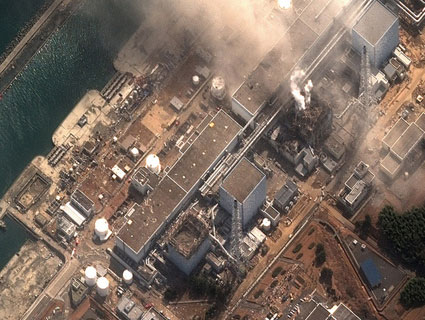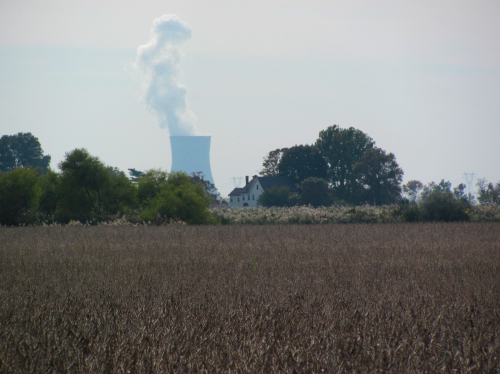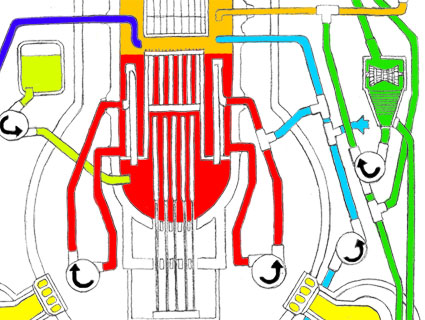
![]() This story first appeared on the TomDispatch website.
This story first appeared on the TomDispatch website.
When nuclear reactors blow, the first thing that melts down is the truth. Just as in the Chernobyl catastrophe almost 25 years ago when Soviet authorities denied the extent of radiation and downplayed the dire situation that was spiraling out of control, Japanese authorities spent the first week of the Fukushima crisis issuing conflicting and confusing reports. We were told that radiation levels were up, then down, then up, but nobody aside from those Japanese bureaucrats could verify the levels and few trusted their accuracy. The situation is under control, they told us, but workers are being evacuated. There is no danger of contamination, but stay inside and seal your doors.
The First Atomic Snow Job
The bureaucratization of horror into bland and reassuring pronouncements was to be expected, especially from an industry where misinformation is the rule. Although you might suppose that the nuclear industry’s outstanding characteristic would be its expertise, since it’s loaded with junior Einsteins who grasp the math and physics required to master the most awesomely sophisticated technology humans have ever created, think again. Based on the record, it’s most outstanding characteristic is a fundamental dishonesty. I learned that the hard way as a grassroots activist organizing opposition to a scheme hatched by a consortium of nuclear utilities to park thousands of tons of highly radioactive fuel rods, like the ones now burning at Fukushima, in my Utah backyard.
Here’s what I took away from that experience: the nuclear industry is a snake-oil culture of habitual misrepresentation, pervasive wishful thinking, deep denial, and occasional outright deception. For more than 50 years, it has habitually lied about risks and costs while covering up every violation and failure it could. Whether or not its proponents and spokespeople are dishonest or merely deluded can be debated, but the outcome—dangerous misinformation and the meltdown of honest civic discourse—remains the same, as we once again see at Fukushima.
Established at the dawn of the nuclear age, the pattern of dissemblance had become a well-worn rut long before the Japanese reactors spun out of control. In the early 1950s, the disciples of nuclear power, or the “peaceful atom” as it was then called, insisted that nuclear power would soon become so cheap and efficient that it would be offered to consumers for free. Visionaries that they were, they suggested that cities would be constructed with building materials impregnated with uranium so that snow removal would be unnecessary. Atomic bombs, they urged, should be used to carve out new coastal harbors for ships. In low doses, they swore, radiation was actually beneficial to one’s health.
Such notions and outright fantasies, as well as propaganda for a new industry and a new way of war—even if laughable today—had tragic results back then. Thousands of American GIs, for instance, were marched into ground zero just after above-ground nuclear tests had been set off to observe their responses to what military planners assumed would be the atomic battlefield of the future. Ignorance, it turns out, is not bliss, and thousands of those soldiers later became ill. Many died young.
Unwary civilians who lived downwind of America’s western testing grounds were also exposed to nuclear fallout and they, too, suffered horribly from a variety of cancers and other illnesses. Uranium miners exposed to radiation in the tunnels where they wrestled from the earth the raw materials for the nuclear age also became ill and died too soon, as did workers processing that uranium into weapons and fuel. Many of those miners were poor Navajos from my backyard in Utah where a new uranium boom, part of the so-called nuclear renaissance, was—before Fukushima—set to take shape.
How Unlikely Risks Become Inevitable
In the future, today’s low-risk claims from industry advocates will undoubtedly seem as tragically naïve as yesterday’s false claims. Yes, the likelihood that any specific nuclear power plant reactor will melt down may be slim indeed—which hardly means inconceivable—but to act as though nuclear risks are limited to the operation of power plants is misleading in the extreme. “Spent fuel” from reactors (the kind burning in Japan as I write) is produced as a plant operates, and that fuel remains super hot and dangerous for hundreds, if not thousands, of years. As we are learning to our sorrow at the Fukushima complex, such used fuel is hardly “spent.” In fact, it can be even more radioactive and dangerous than reactor cores.
 Spent fuel continues to pile up in a nuclear waste stream that will have to be closely managed and monitored for eons, so long that those designing nuclear-waste repositories struggle with the problem of signage that might be intelligible in a future so distant today’s languages may not be understood. You might think that a danger virulent enough to outlast human languages would be a danger to avoid, but the hubris of the nuclear establishment is equal to its willingness to deceive.
Spent fuel continues to pile up in a nuclear waste stream that will have to be closely managed and monitored for eons, so long that those designing nuclear-waste repositories struggle with the problem of signage that might be intelligible in a future so distant today’s languages may not be understood. You might think that a danger virulent enough to outlast human languages would be a danger to avoid, but the hubris of the nuclear establishment is equal to its willingness to deceive.
A natural disaster, accident, or terrorist attack that might be statistically unlikely in any year or decade becomes ever more likely at the half-century, century, or half-millennium mark. Given enough time, in fact, the unlikely becomes almost inevitable. Even if you and I are not the victims of some future apocalyptic disturbance of that lethal residue, to consign our children, grandchildren, or great-grandchildren to such peril is plainly and profoundly immoral.
Nuclear proponents have long wanted to limit the discussion of risk to plant operation alone, not to the storage of dangerous wastes, and they remain eager to ignore altogether the risks inherent in transporting nuclear waste (often called “mobile Chernobyl” by nuclear critics). Moving those spent fuel rods to future repositories represents a rarely acknowledged category of potential catastrophe. Just imagine a trainload of hot nuclear waste derailing catastrophically along a major urban corridor with the ensuing evacuations of nearby inhabitants. It means, in essence, that one of those Fukushima “pools” of out-of-control waste could “go nuclear” anywhere in our landscape.
Risk is about more than likelihood; it’s also about impact. If I tell you that your chances of being bitten by a mosquito as you cross my yard are one in a hundred, you’ll think of that risk differently than if I give you the same odds on a deadly pit viper. As events unfold in Japan, it’s ever clearer that we’re talking pit viper, not mosquito. You wouldn’t know it though if you were to debate nuclear industry representatives, who consistently downplay both odds and impact, and dismiss those who claim otherwise as hysterical doomsayers. Fukushima will assumedly make their task somewhat more difficult.
Hidden Costs and Wasted Subsidies
The true costs of nuclear power are another subject carefully fudged and obscured by nuclear power advocates. From its inception in federally funded labs, nuclear power has been highly subsidized. A recent report by the Union of Concerned Scientists found that “more than 30 subsidies have supported every stage of the nuclear fuel cycle from uranium mining to long-term waste storage. Added together, these subsidies have often exceeded the average market price for the power produced.” When it comes to producing electricity, these subsidies are so extensive, the report concludes, that “in some cases it would have cost taxpayers less to simply buy the kilowatts on the open market and give them away.”
If the nuclear club in Congress, led by Senate Republican leader Mitch McConnell, gets its way, billions more in subsidies will be forthcoming, including massive federal loan guarantees to build the next generation of nuclear plants. These are particularly important to the industry, since bankers won’t otherwise touch projects that are notorious for mammoth cost overruns, lengthy delays, and abrupt cancellations.
The Obama administration has already proposed an additional $36 billion in such guarantees to underwrite new plant construction. That includes $4 billion for the construction of two new nuclear reactors on the Gulf Coast that are to be operated in partnership with Tokyo Electric Power Company—that’s right, the very outfit that runs the Fukushima complex. Yet when I debate nuclear advocates, they always claim that, in cost terms, nuclear power outcompetes alternative sources of energy like wind and solar.
That government gravy train doesn’t just stop at new power plants either. The feds have long assumed the epic costs of waste management and storage. If another multi-billion dollar project like the now-abandoned Yucca Mountain repository in Nevada is built, it will be with dollars from taxpayers and captive ratepayers (the free market be damned). Industry spokesmen insist that subsidizing such projects will be well worth it, since they will create thousands of new jobs. Unfortunately for them, a definitive 2009 University of Massachusetts study that analyzed various infrastructure investments including wind, solar, and retrofitting buildings to conserve energy placed nuclear dead last in job creation.
Finally, the recently renewed Price-Anderson Nuclear Industries Indemnity Act limits the liability of nuclear utilities should a catastrophe like the one in Japan happen here in the United States. The costs of recovery from the Fukushima catastrophe will be astronomical. In the US, nuclear utilities would be off the hook for any of those costs and you, the citizen, would foot the bill. Despite their assurances that nothing can go wrong here, nuclear industry officials have made sure that in their business risk and reward are carefully separated. It’s a scenario we should all know well: private corporations take away profits when things go well, and taxpayers assume responsibility when shit happens.
Finally, nuclear power boosters like to proclaim themselves “green” and to claim that their industry is the ideal antidote to global warming since it produces no greenhouse gas emissions. In doing so, they hide the real environmental footprint of nuclear energy.
It’s quite true that no carbon dioxide comes out of power-plant smokestacks. However, maintaining any future infrastructure to handle the industry’s toxic waste is guaranteed to produce lots of carbon dioxide. So does mining uranium and processing it into fuel rods, building massive reactors from concrete and steel, and then behemoth repositories capable of holding waste for 1,000 years. Radiation from the Fukushima meltdown is now entering the Japanese food chain. How green is that?
The Watchdogs Play Dead
Over the course of nuclear power’s history, there have been scores of mishaps, accidents, violations, and problems that, chances are, you’ve never heard about. Beyond the unavoidable bad PR over the partial meltdown at Three Mile Island in 1979, the Chernobyl meltdown in 1986, and now the Japanese catastrophe, the industry has an excellent record—of covering up its failures.
The co-dependent relationship between the nuclear corporations and the Nuclear Regulatory Commission (NRC), the federal agency charged with licensing and monitoring them, resembles the cozy relationship between the Securities Exchange Commission and Wall Street before the global economic meltdown of 2008. The NRC relies heavily on the industry’s own reports since only a small fraction of its activities can be inspected yearly.
A report by the Union of Concerned Scientists, “The NRC and Nuclear Power Plant Safety in 2010,” which highlights the NRC’s haphazard record of inspection and enforcement, makes clear just why the honor system that assumes utilities will honestly report problems has never worked. It describes 14 recent serious “near miss” violations that initially went unreported. At the Indian Point Nuclear Power Plant, only 38 miles north of the New York metropolitan area, for instance, NRC inspectors ignored a leaking water containment system for 15 years.
After a leaking roof forced the shutdown of two reactors at the Calvert Cliffs nuclear facility in Maryland, plant managers admitted that it had been leaking for eight years. When Honeywell hired temporary workers to replace striking union members at its uranium refinery in Illinois, they were slipped the correct answers to a test required for those allowed to work at nuclear plants, because otherwise they had neither the knowledge nor experience to pass.
The regulation of Japan’s nuclear industry mirrors the American model. Japan’s legacy of regulatory scandals, falsified safety records, underestimated risks, and cover-ups includes an incident in 1999 when workers mixed uranium in open buckets and exposed hundreds of coworkers to radiation. Two later died. Other scandals involved hiding cracks in steam pipes from regulators in 1989, lying about a fire and explosion at a plant near Tokyo in 1997, and covering up damage to a plant from an earthquake in 2007.
In the wake of the Fukushima catastrophe, we will no doubt discover how there, too, so-called watchdogs rolled over and played dead. In recent years, in fact, the Fukushima complex had the highest accident rate of any of the big Japanese nuclear plants. We’ve already learned that an engineer who helped design and supervise the construction of the steel pressure vessel that holds the melting fuel rods in Reactor No. 4 warned that it was damaged during production. He had himself initially orchestrated a cover-up of this fact, but revealed it a decade later—only to be ignored. During the complex’s construction by General Electric some 35 years ago, Dale Bridenbaugh, a GE employee, resigned after becoming convinced that the reactors being built were seriously flawed. He, too, was ignored. The Vermont Yankee reactor in Vermont and 23 others around the US replicate that design.
Stay tuned, since more examples of reckless management will surely come to light…
Risk Is Not a Math Problem
That culture of secrecy is a logical fit for an industry that is authoritarian by nature. Unlike solar or wind power, nuclear power requires massive investments of capital, highly specialized expertise, robust security, and centralized control. Any local citizen facing the impact of a uranium mine, a power plant, or a proposed waste depository will attest that the owners, operators, and regulators of the industry are remote, unresponsive, and inaccessible. They misinform because they have the power to get away with it. The absence of meaningful checks and balances enables them.
Risk, antinuclear advocates quickly learn, is not simply some complicated math problem to be resolved by experts. Risk is, above all, a question of who is put at risk for whose benefit, of how the rewards, costs, and liabilities of an activity are distributed and whether that distribution is fair. Those are political questions that citizens directly affected should be answering for themselves. When it comes to nuclear power, that doesn’t happen because the industry is undemocratic to its core. Corporate officers treat downwind stakeholders with the same contempt they reserve for honest accountings of the industry’s costs and dangers.
It may be difficult for the average citizen to unpack the technicalities of nuclear power, or understand the complex physics and engineering involved in splitting atoms to make steam to produce electricity. But most of us are good at detecting bullshit. We know when something like the nuclear industry doesn’t pass the smell test.
There is a growing realization that our carbon-based energy system is warming and endangering this planet, but replacing coal and oil with nuclear power is like trading heroin for crack—different addictions, but no less unhealthy or risky. The “nuclear renaissance,” like the “peaceful atom” before it, is the energy equivalent of a three-card monte game, involving the same capitalist crooks who gave us oil spills, bank bailouts, and so many of the other rip-offs and scams that have plagued our lives in this new century.
They are serial killers. Stop them before they kill again. Credibility counts and you don’t need a PhD or a Geiger counter to detect it.
Chip Ward was a founder of HEAL Utah, a grassroots group that has led the opposition to the disposal of nuclear waste in Utah and the construction of a new reactor next to Green River. A TomDispatch regular, he is the author of Canaries on the Rim: Living Downwind in the West and Hope’s Horizon: Three Visions for Healing the American Land. To listen to Timothy MacBain’s latest TomCast audio interview in which Ward discusses the endless legacy of nuclear power, click here, or download it to your iPod here.















